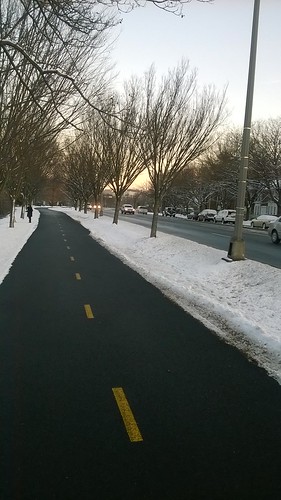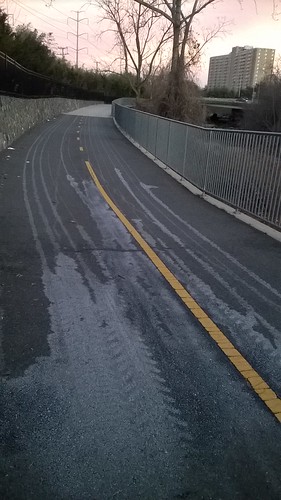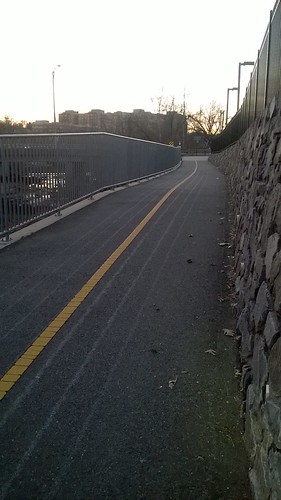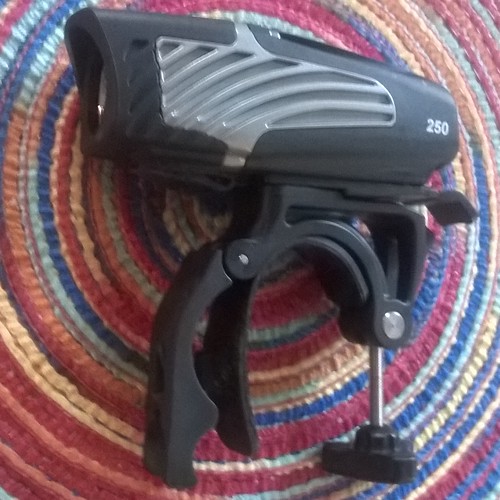When the first diamond frame bicycles became popular in the 1890s they were often called "wheels" - the national cycling association was called the "League of American Wheelmen." We have moved from "wheels" to "bikes," but the bicycles have remained remarkably the same over more than 100 years - elegant in their efficiency and simplicity. And many of the issues that we think are new? They were around then too.
Friday, January 9, 2015
Studded Tire Performance in Icy Weather
Photo from several years ago, but bike and tires look same now
I have a 15+ year old heavy ChroMoly Giant mountain bike with studded mountain bike tires - they were sold under the NashBar brand, but were made by Kenda (I think). 1.95 (or really 2) inches wide. There are two rows of studs, kind of alternating in position relative to one another looking across the tire. They are far enough out from the center of the tire that one can significantly influence how many studs may be in contact with the ground by changes in the tire pressure.
Three days ago it was snow, not ice, and I had the tires at 55 pounds per square inch. I made pretty good time but the studs were not really necessary. Two days ago the conditions were much more icy for about half the ride, in other words, the part that is NOT MAINTAINED BY THE NATIONAL PARK SERVICE (unlike Arlington County, which pretreats its bike trails, God help us). I rode to and from work with the tires inflated only to 40 pounds per square inch and clearly that improved the studly-stickiness of the tires - very little sliding around. On the other hand, on bare pavement, the road resistance is pretty noticeable (and unpleasant). A compromise.
Typical Mount Vernon Trail conditions - thanks for nothing, NPS
This morning I increased the pressure to 50 pounds per square inch since I was hopeful that the trails would be more clear today, but there were still significant areas that were covered from one side of the trail to the other. 50 pounds per square inch was too much to have the same kind of good traction that 40 provides, but I chose to ride along the edges of the trails where there was less bare ice or in a few cases off on the frozen ground along the trail. The improvement in rolling resistance by having more air in the tires made up for a small amount of slow riding in the few really bad spots.
I have now had these studded tires for something like eight years - maybe more. Of course there was at least one year where I didn't use them at all, but I don't ride them much. Originally I thought that if I rode what must be cheap metal studs on lots of bare pavement that I would pound them flat (ruin them) in no time, but in fact they seem to show little wear at all.
Last year I realized that I had lost several on each tire - they are kind of like short thick nails, with a head at the opposite end from what sticks out of the tire. Nashbar sells replacement studs with a tool for installing them and that works fine. I am now riding with a full complement of studs.
I see that there are road tires with studs - the rows of studs are of course much closer to each other. I assume that overall in most urban conditions these would be faster but for now I will stick with the mountain bike approach.
Thursday, January 8, 2015
A Bicycle Race as Analogy for Federal Budget-Making (1898)
From the cover of Puck magazine, 1898 (cropped version)
Image of the full cover.
Item record from the Library of Congress
Title: A handicap needed / Dalrymple.
Creator(s): Dalrymple, Louis, 1866-1905, artist
Date Created/Published: N.Y. : Published by Keppler & Schwarzmann, 1898 January 12.
Medium: 1 print : chromolithograph.
Summary: Print shows a bicycle race on the "National Track" with the man in the lead labeled "National Expenses" easily outstripping the second bicyclist labeled "National Revenue"; a man labeled "Dingley" is giving the second bicyclist a push.
Reproduction Number: LC-DIG-ppmsca-28769 (digital file from original print)
Rights Advisory: No known restrictions on publication.
Call Number: Illus. in AP101.P7 1898 (Case X) [P&P]
Repository: Library of Congress Prints and Photographs Division Washington, D.C. 20540 USA http://hdl.loc.gov/loc.pnp/pp.print
Perhaps not surprisingly, I am more of a Krugman-ite in my economic views so I don't actually see that some imbalance in this race is a problem. It seems reasonable to me that some of our economic thinking today could be more advanced than the economic thinking of 1898, right?
I think it is correct that this is an analogy, but like most semi-educated folk (I have two masters degrees but was never able to open the door behind which I would have found a PhD) I am not always right in the simile-metaphor-analogy parsing process.
The illustration shows the Capitol dome off to the left; perhaps this "National Track" is supposed to be on Hains Point?
Tuesday, January 6, 2015
Arlington Trail Snow Removal ROCKS

At long last, parity (if only in Arlington)
Clear roads and clear trails, on the same day. Thanks County government!!

Where Arlington County trail clearing ends
I stopped on my way home to take this photo. This is where Arlington County's trail clearing efforts came to an end - the Mount Vernon Trail maintained by the National Park Service has had nothing done and tomorrow will be an icy mess.
My photo doesn't show it clearly, but it is pretty funny (to me) how Arlington's mini-plow went in a nice little circle clearing the trail before heading back into Arlington.
I suppose the National Park Service will do something when hell freezes over.
Arlington County Plows Bike Trails Early
Arlington Country bike trail along Four Mile Run - plowed at 6:45 am
The DC streets I saw, however, were not plowed at all. Crazy.
Monday, January 5, 2015
Arlington County Pre-Treats Bike Trails
Tomorrow we may have and inch or two of snow, starting around 4-5 am. Maybe.
There had been discussion of more allocation of resources to clear snow from "mixed use" (that is, bike) trails, but I had not realized this could include pre-treatment before the snow. On my way home today, turning off the Mount Vernon Trail onto the trail along Four Mile Run, I noticed the tell-tale lines on the pavement indicating some kind of vehicle had come through and applied some kind of treatment in advance of the snow's arrival.

Looking away from Shirlington, you can see the application of some sort of liquid treatement both coming and going
Apparently this is where the vehicle turned around since a fair amount was spilled.

Looking towards Shirlington, you can see that the narrower trail means just one direction of application
I have no idea how helpful this will be. Find out tomorrow, most likely.
There had been discussion of more allocation of resources to clear snow from "mixed use" (that is, bike) trails, but I had not realized this could include pre-treatment before the snow. On my way home today, turning off the Mount Vernon Trail onto the trail along Four Mile Run, I noticed the tell-tale lines on the pavement indicating some kind of vehicle had come through and applied some kind of treatment in advance of the snow's arrival.

Looking away from Shirlington, you can see the application of some sort of liquid treatement both coming and going
Apparently this is where the vehicle turned around since a fair amount was spilled.

Looking towards Shirlington, you can see that the narrower trail means just one direction of application
I have no idea how helpful this will be. Find out tomorrow, most likely.
Tuesday, December 30, 2014
Perfect Bicycle Christmas Gift
The NYTimes had a economics-related blog post, An Economist Goes Christmas Shopping that I found myself considering as I contemplated several different bicycle-related presents I received this Christmas. One argument (not that of the blog post) is that many if not most presents are not good expenditures since the person buying the present hardly can do as well as the recipient what the recipient would really want - "why should you shop for me, when I certainly know what I want better than you do?" The comeback logic is, "to try to buy something that the recipient didn’t know he or she wanted" which is possible when the person giving the gift knows the recipient well.
A Pearl-Izumi "Barrier" cap
By this standard, my wife gave me the perfect Christmas gift since I didn't know I wanted this cycling cap until I received it. In rainy weather I have either worn just a baseball cap under my helmet or when it is cooler, a hat that covers my ears pulled over the baseball cap and then tried to cram on a helmet over both of them. The results aren't particularly comfortable although the main goal, keeping rain from running down my face, is well accomplished.
This cap with its smaller bill should do fine for keeping water off my fact but also will fit under my helmet much better, even if I decide to wear it under another hat. I like it.
Chrome Industries mystery cycling (t-)shirt
My brother-in-law Robert's family gave me a pretty good present too - a close second. In the three or four years I have acquired several Merino wool cycling jerseys plus a Merino wool long-sleeve "base layer" (not specifically intended for cycling).
What they gave me was a Merino v-neck t-shirt that the company Chrome Industries calls a cycling jersey - but one that doesn't look like a cycling jersey. Which is certainly true; it looks like a well made t-shirt and has no pockets at all (unlike most cycling jerseys). The shirt has 10 percent nylon and 90 percent wool, which I don't think is noticeable - it is somewhat heavier than the "base layer" garment. Very comfortable - it just feels good.
It appears that Chrome Industries discontinued trying to sell these shirts because they aren't on their site. Perhaps it was because of the cost, which according to what seems to be a web developer site (accidentally indexed by Google) the price was $70. I am thinking my relatives purchased a closeout version. Which would make sense!!
Long sleeve cycling shirt (with Australian URL)
My brother-in-law Paul did a good job, too - he was the person who first bought me a Merino cycling jersey several years ago adn this year he gave me this long sleeve jersey (not wool . . . ) with the amusing "evolution" graphic on the back. Apparently 1791 is considered (by some) to be the year that bicycles were invented. This will be great to wear on rides in the spring. Again, this is not something I would think to buy but I am glad to have it.

NiteRider 250 lumen light
On the other hand, I have a different example. I had ordered a jacket for one of my sons and since I was going to get free shipping and had some "points" that would reduce the cost, I (finally) ordered a new front bike light. I have been using the same 100 lumen NiteRider unit for three or four years - it has a separate battery with a short cable that is supposed to be attached to the stem, behind the handlebars. It isn't a great arrangement. I did have a problem with it and got good service from NiteRider so I bought another NiteRider light, a Lumina Micro 250, that is a little brighter. It is very nice.
I think it more to do with categories - with cycling clothes, it is simpler for others to think of something that I will enjoy and use than it is for a basic bit of hardware like a light.
A Pearl-Izumi "Barrier" cap
By this standard, my wife gave me the perfect Christmas gift since I didn't know I wanted this cycling cap until I received it. In rainy weather I have either worn just a baseball cap under my helmet or when it is cooler, a hat that covers my ears pulled over the baseball cap and then tried to cram on a helmet over both of them. The results aren't particularly comfortable although the main goal, keeping rain from running down my face, is well accomplished.
This cap with its smaller bill should do fine for keeping water off my fact but also will fit under my helmet much better, even if I decide to wear it under another hat. I like it.
Pearl Izumi's barrier cycling cap combines the functionality of a cycling cap with the cold-weather protection of P.R.O. thermal fabric. It keeps your head warm and the sun out of your eyes, all while stylishly fitting under your helmet. Plus, this stellar headpiece boasts a ponytail cut-out and reflective accents.I am afraid I have not had a ponytail for ten years or so. Also, I find it amusing when the company logo is done in some reflective material and this is termed a "reflective accent" as if it improves the rider's visibility. Hmmm.
Chrome Industries mystery cycling (t-)shirt
My brother-in-law Robert's family gave me a pretty good present too - a close second. In the three or four years I have acquired several Merino wool cycling jerseys plus a Merino wool long-sleeve "base layer" (not specifically intended for cycling).
What they gave me was a Merino v-neck t-shirt that the company Chrome Industries calls a cycling jersey - but one that doesn't look like a cycling jersey. Which is certainly true; it looks like a well made t-shirt and has no pockets at all (unlike most cycling jerseys). The shirt has 10 percent nylon and 90 percent wool, which I don't think is noticeable - it is somewhat heavier than the "base layer" garment. Very comfortable - it just feels good.
It appears that Chrome Industries discontinued trying to sell these shirts because they aren't on their site. Perhaps it was because of the cost, which according to what seems to be a web developer site (accidentally indexed by Google) the price was $70. I am thinking my relatives purchased a closeout version. Which would make sense!!
Long sleeve cycling shirt (with Australian URL)
My brother-in-law Paul did a good job, too - he was the person who first bought me a Merino cycling jersey several years ago adn this year he gave me this long sleeve jersey (not wool . . . ) with the amusing "evolution" graphic on the back. Apparently 1791 is considered (by some) to be the year that bicycles were invented. This will be great to wear on rides in the spring. Again, this is not something I would think to buy but I am glad to have it.

NiteRider 250 lumen light
On the other hand, I have a different example. I had ordered a jacket for one of my sons and since I was going to get free shipping and had some "points" that would reduce the cost, I (finally) ordered a new front bike light. I have been using the same 100 lumen NiteRider unit for three or four years - it has a separate battery with a short cable that is supposed to be attached to the stem, behind the handlebars. It isn't a great arrangement. I did have a problem with it and got good service from NiteRider so I bought another NiteRider light, a Lumina Micro 250, that is a little brighter. It is very nice.
Big things come in small packages and the Lumina Micro 250 is the proof. Smaller and more compact than the original Lumina series, the Lumina Micro 250 delivers a powerful punch with 250 lumens of light output.I then handed this off to one of my sons and said he could give it to me for Christmas - apparently at that moment I was buying into the logic that only I know what I need (or want~).
I think it more to do with categories - with cycling clothes, it is simpler for others to think of something that I will enjoy and use than it is for a basic bit of hardware like a light.
Saturday, December 27, 2014
Steel Bike or Carbon Bike-Which More Pleasing?
Retro Bike Or Modern Bike? How Have Bikes Changed? from Global Cycling Network (YouTube channel)
I found the above video on VeloNews - I found it interesting because in some respects it reflects many of the differences between the two different bikes I use for commuting to and from work. I have a 1982 Bridgestone road bike and a 2006 Scattante CFR. The difference in the age of the two bikes I have and the bikes discussed in the video is roughly the same, but obviously a 2014 road bike has some technical advantages over my 2006.
1982 Bridgestone Sirius road bike frame and fork
This is not a "period correct" 1982 road bike - the frame and the fork are original 1982 Japanese steel but the rest of it varies by period. The stem and handlebars are from around 1982 but the drive train and brakes are from the late 1980s - I wanted something more advanced, particularly for the brakes. The wheels, seat post, and saddle are new. I added fenders to make it a good bike to ride in rainy weather.
(I have blogged about this bike before - anyway, I find it pleasing because I bought the frame for less than 100 dollars on eBay and it has a number of rather amazing features, including the Tange headset, fork and crown, and Tange lugs. The doublebutted tubes are from Bridgestone. But this Bridgestone precedes Grant Petersen's association with Bridgestone road bike design, alas.)
2006 Scattante CFR road bike (from Performance)
There is nothing special about this frame as such except that at the time I bought it, it was the entry level all carbon fiber frame from Performance Bike - the bike came with mostly Ultegra or other reasonably good components and no Performance house brand junk.
My carbon fiber bike with pedals weighs around 20 pounds while the Bridgestone weighs about 25-26. (On the video they also talk about a five pound or two kilo difference, but I think they are talking about 15-16 pounds for the carbon fiber bike and around 20-21 for the steel bike.) I sense that the weight matters mostly when trying to climb hills, but that isn't generally a problem with the rides I do around here. The video describes the introduction of integrated brake lever-shifters as of almost as much significance as the introduction of derailleurs, but that seems a little crazy. If you ride bikes with downtube shifters (like the older one has) regularly enough it isn't that big a deal - the downtube shifters are located right along an arc that your hand travels down in that direction so I never have to look. Even when braking, mostly one is braking with the left hand and shifting down with the right hand - no problem. And I find the maintenance for a road bike that is used for commuting is much less with the downtube shifters than with the brifters, which can be annoying to maintain and expensive to replace (and generally not easily repaired) if something goes wrong inside of one.
I think it is interesting that he the guy on the older bike says that the leather soled shoes give up "80 watts every revolution" but that the clip-in pedals otherwise are not better than using toe-straps. It isn't even that clear that having your feet secured to the pedals (however it is done) increases overall efficiency in pedaling.
I am certain that I am able to average a higher speed when riding the carbon fiber bike, but I think it is largely because it has an 11-25 set of ten rings in back while the steel road bike has only 7 rings, running from 28 to 11. My optimum cadence is apparently narrow because it isn't that unusual that I find on the steel bike that I am not challenged by a particular gear but am uncomfortable with the next one up - this is rarely a problem with the bike with 10 rings.
There are likely a variety of small inefficient aspects to the steel bike compared to the carbon fiber bike that also add up, favoring the carbon fiber one. For example, the steel bike has a very basic inexpensive square taper bottom bracket that I bought to replace the original one that came with it (that froze up after about three months of riding). The carbon fiber bike has some Ultegra grade modern (for 2006) bottom bracket that surely must be better. And the fenders on the steel bike clearly capture a fair amount of air on windy days - not so much head on, but coming from angles from the front.
Some of the modern differences don't affect their relative performance as far as I can see. I understand that the modern threadless headset is intrinsically stronger than the threaded headset in the steel bike (that is original, from 1982) but it isn't obvious to me that it matters in every day riding. One comment the rider on the older bike in the video makes is that the small steel tubing looks less strong to him compared to the oversized carbon fiber tubing - this is amazing to me since I get my sense of the strength of the materials from pinging the tubes with a finger - the carbon fiber feels like nothing, while the steel tubing feels like (duh) steel!
At some point the fellow on the steel bike comments on the smoothness of the ride, apparently attributing that to the steel frame. I guess I am somewhat doubtful - I understand that aluminum frames transmitted road roughness a lot, but my impression is that my carbon fiber and my steel bike are mostly differentiated in how they smooth the road by how much air I put in the tires, and the size of the tires. I have 25 mm tires on the steel bike - if I take them up over 100 pounds per square inch, the ride is pretty stiff and picks up everything. The 23 mm tires on the carbon fiber bike can go much higher, but anywhere over 110 pounds per square inch and the ride just picks up too much road noise to be pleasant. Apparently frame stiffness is a fairly complicated issue but I think both my steel bike and carbon fiber bike flex enough. But not too much.
This relatively new 2008 steel bike annoyingly combines the worst of several worlds
I don't have the desire right now to complain about this bike that I also own (but it now in an unusable state), which I am suspicious suffers from an overly stiff tube design. And is too complicated in a number of ways. Ugh.
Subscribe to:
Comments (Atom)